In this article you’ll learn how to construct the G sharp minor triad as well as how to play it on piano and guitar.
We’ve also included sections on inversions for those that want a deeper understanding. Lastly, listen to some examples of popular songs that featured this triad.
Root, 3rd and 5th
The G sharp minor triad is formed of the 1st, flat 3rd and flat 5th of the G sharp major scale.
- G# – root note
- B – minor 3rd above the root
- D# – perfect 5th above the root
Here is the triad written on the stave in the treble and bass clef.


Before you read on make sure that you have a basic understanding of intervals. Intervals are vital for understanding how triads are built. Check out our guide to major, minor and perfect intervals for more on this.
G sharp Minor Triad on Piano
Below you can see how to play this triad on the keyboard or piano. This pattern of notes could also be played starting on any G sharp note.
However, the order of the notes must be the same:
- G sharp – lowest note
- B – middle note
- D sharp – highest note
This is called ‘root position’.
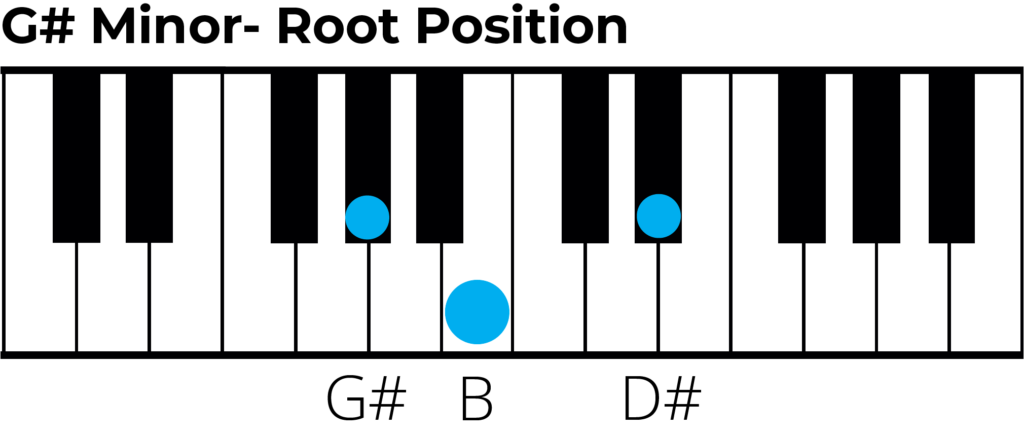
G# Minor Triad on Guitar
There are two simple positions that you can use to play a G# minor triad on guitar. Both positions can also be slide up or down the neck to play different minor triads.

1st Inversion
A 1st inversion is where we take a triad but we start on the second note, which in this case is B natural. We still keep the D# above, but then the G# (or root) become the highest note.
This way of rearranging a triad gives us a different sound as the relative pitches of the three notes has changed.
- B – lowest note
- D# – middle note
- G# – highest note

1st inversion on Piano
On the piano we can play the 1st inversion of a G# Minor triad by starting on a B. They play the D sharp above and the G sharp above this.
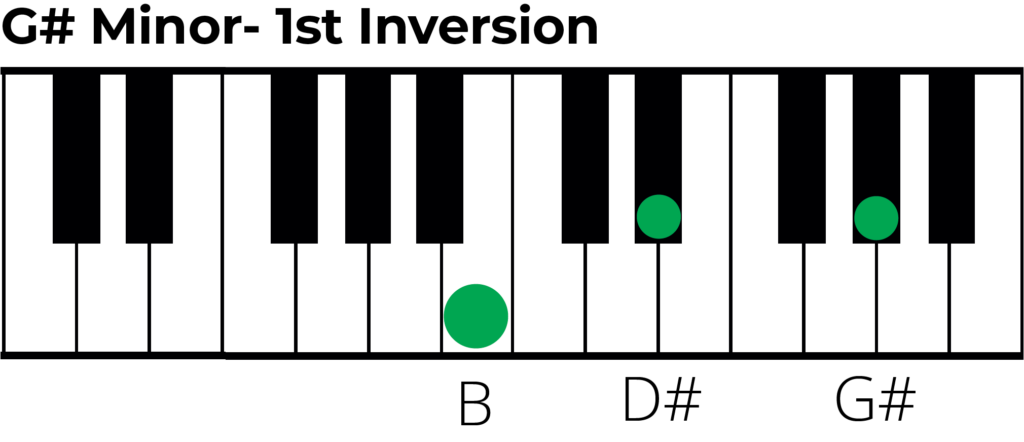
1st Inversion on Guitar
Below are the most common shapes for playing a G# minor triad in the 1st inversion. Remember that we can only use certain shapes are the pitches of the three notes are important.
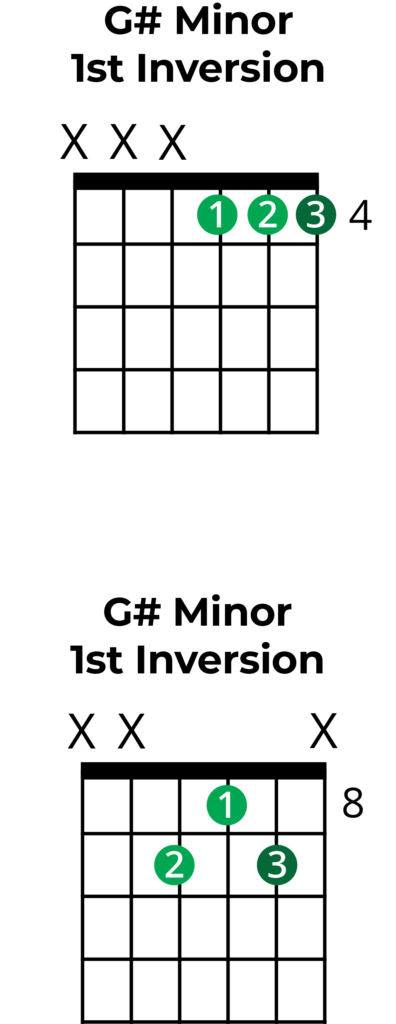
2nd Inversion
A 2nd inversion is where we take a triad but we start on the third note, which in this case is D sharp. We still keep the G sharp above this as we did from the 1st inversion. Then the B becomes the highest note in the chord.
- D# – perfect 5th (lowest note)
- G# – root note (middle note)
- B – minor 3rd (highest note)
We could construct a 2nd inversion starting on any D sharp note in any octave. The only thing that must stay the same is that the we use the G sharp above and the B above that.

2nd inversion on Piano
On the piano we can play the 2nd inversion of a G# Minor triad by starting on a D#. They play the G# above and the B above this.
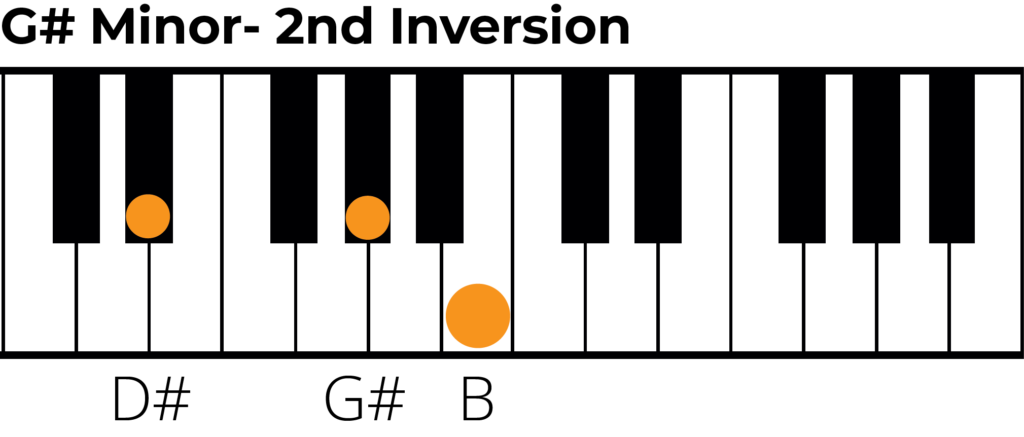
2nd Inversion on Guitar
Below are the most common shapes for playing a G# minor triad in the 2nd inversion. Remember that we can only use certain shapes are the pitches of the three notes are important.
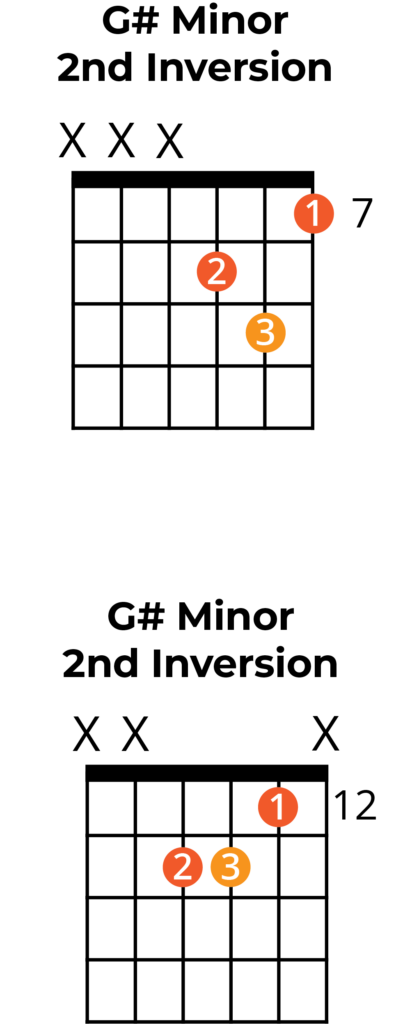
Triads from the G sharp Minor Scale
By looking at the G sharp Minor scale we can actually make triads built on each note and only using notes from G sharp minor scale. Below you can see a list of each triad we will create be starting on different notes of the scale.
- G# Minor
- A# Dim
- B Major
- C# Minor
- D# Minor
- E Major
- F# Major

Pieces in G sharp Minor
Here’s 3 famous examples of songs in the key of G sharp minor. For this reason, they use G sharp Minor chords, as the root note chord, prominently in their chord progressions.
‘Naive’ – The Kooks
The Kooks’ ‘Naive’ is a catchy indie rock song with an upbeat tempo and infectious melody. It exemplifies the band’s signature sound and their contribution to the alternative music scene.
‘Snow (Hey Oh)’ – Red Hot Chili Peppers
Red Hot Chili Peppers’ ‘Snow (Hey Oh)’ is a dynamic rock track acclaimed for its guitar work and poetic lyrics.
‘Poker Face’ – Lady Gaga
Lady Gaga’s ‘Poker Face’ is an infectious pop hit known for its catchy hooks and suggestive lyrics. It contributed to the artist’s rise as a pop culture icon during the late 2000s.
What’s next….?
- Learn how to construct the G sharp Major triad
- Swat up on your chord knowledge with our complete guide to chords.
